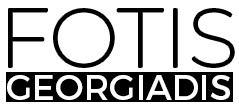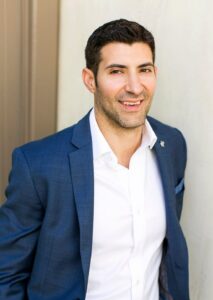The Future Is Now: Gabe Frank Of Arcade On How Their Technological Innovation Will Shake Up The Tech Scene
An Interview With Fotis Georgiadis
Learn to shrug off criticisms and focus on the positive. When you have a vision you believe in, to stay focused on achieving your goal, stay positive, and be determined to prove naysayers wrong.
As a part of our series about cutting edge technological breakthroughs, I had the pleasure of interviewing Gabe Frank.
Gabe Frank is CEO of Arcade, the most sophisticated DeFi NFT lending infrastructure. A third-generation pawnbroker, Gabe helped run the family business of 9 storefronts under the name Benny’s Pawn, founded in 1947 and eventually acquired in 2016. Through this real-world experience Gabe learned the importance of collateralized loans against physical assets and developed and ran an online sub-prime loan portfolio. An early NFT enthusiast and DeFi advocate, Gabe brings expertise from consumer and traditional financial markets to Arcade, having previously supported BitGo growing their digital asset custody (AUC) to over $1B and assisted BitGo Prime in building an institutional lending book to over $150m. Later, Gabe joined Curv where he introduced the first-of-its-kind institutional Metamask product built for DeFi hedge funds and fintechs.
Thank you so much for doing this with us! Can you tell us a story about what brought you to this specific career path?
Absolutely! Before I got into crypto, I was working with my dad right out of college as a third-generation pawnbroker in El Paso, Texas. My family owned a chain of storefront Pawn Shops that my grandfather originally started in 1947. I learned a lot working with my Dad and seeing first hand how to run an organization. Working there I made consumer loans, both collateralized and uncollateralized. And that’s where I learned lending and borrowing on non-fungible, physical assets. Then in 2016, we sold that business, and what had by then become a sizable online small dollar short-term lending portfolio. That’s when I got into crypto. I worked in crypto for three years, employed at two custodians, BitGo and Curve. During that time, I was also getting involved in DeFi and NFTs as a collector and realized it was a lot of fun. So, from collecting NFTs and being in the space, knowing all the big players and kind of the inner workings of the ecosystem, I realized that there was an infrastructure gap in Web3. I found a market fit to try and build something like what I envisioned as Arcade. So, I paired up with my co-founder, Robert, who was one of my clients at BitGo, and we started working on this kind of nights and weekends while we both had full time jobs, decided to raise a seed round and then we both dedicated ourselves to Arcade full time and haven’t looked back.
Can you share the most interesting story that happened to you since you began your career?
I started working at BitGO, during basically, the heart of the bear market, throughout 2018/2019 When the market was down 80–90% from the peak. During that time, I remember talking to one of my coworkers at the time, and saying, you know, tokens and all of these applications that had tokens were kind of dead, and I just kind of pondered about what the next big thing would be. And now suddenly, three years later we’re in a raging bull market, the space is attracting a lot of talent and capital, and things are kind of moving from Web 2 to Web 3, and now it’s all about tokens again, and what you can do with tokens and community owned protocols. So, we kind of went from thinking that this approach was the end, asking ‘why do you need a token for everything’, to now this is definitely the way the internet’s going to work at a basic level. Now, it’s community owned protocols, where users of the protocol can interact in the governance of it. And we’re starting to see applications being built that have billions of dollars being worked, very different from empty promises and white papers, like the ICO days in 2017, but real applications that are creating new jobs, new users, new businesses, and new ways to conduct business online.
Can you tell us about the cutting edge technological breakthroughs that you are working on? How do you think that will help people?
The application we’re building is a decentralized application built on Ethereum. One of the cool things that NFTs and blockchain allow people to do is to prove ownership on scarce digital goods. When you think of music being downloaded every single time on the internet, well a song is sort of non-fungible in itself, but it can be downloaded as many times as possible without the artist/creator being fairly compensated, and losing its provenance. However, now with NFTs we have a mechanism that allows Internet assets to be scarce and to prove provenance of those assets and online IP. And so what we’re doing is allowing any, basically on-chain asset on Ethereum today to be able to be collateralized and to get liquidity from. So, you can start to see the world is going to get a lot more liquid in terms of what can I do with these digital assets and how can I maximize my spending and earning potential? Capital efficiency comes to mind. That’s a huge benefit to users in any market and this is a new asset class, so access to credit and new credit markets are going to open up and unlock a lot more ways to conduct finance in an on-chain, and entirely new way.
How do you think this might change the world?
As we start to move assets on-chain, and that means, you know, today, it’s digital art and collectibles that have basically disrupted the traditional collectible market. Now we’re seeing top name brands getting into the space and creating new forms of user value, with new and innovative ways to connect more to their user base. So the world starts to look a lot more composable. You have all these different applications working together, where value is captured by the user. So, you can think of any top internet company today, Facebook, Amazon, Google, all the value gets captured by the entity itself. But with Web3 protocols, now, the ownership is with the user base. The other part of this is the new creator economy. New ways for internet users to monetize their online IP. Everyone is a creator.
Keeping a “Black Mirror-esque” scenario in mind, can you see any potential drawbacks about this technology that people should think more deeply about?
Blockchains are permissionless and immutable, so that allows basically any sort of financial activity to happen without safeguards in place, because the blockchain is a bunch of different nodes all over the world and once the code is released on chain it can’t be censored. They’re there forever. So we should always think about protecting the platform and protecting against illicit activity. We have these automatic, permissionless protocols, and they’re good because it opens up a new world of a native internet economy, but it’s always mindful to think about protecting against any sort of bad actors on the platform.
Was there a “tipping point” that led you to this breakthrough? Can you tell us that story?
It was around early 2020, they call that “the defi summer”, when new defi tokens and applications started being created and market caps soaring into the billions. I started collecting a few digital art pieces and thought it was really fun. Then I realized, if I was having fun, then other people were going to have fun collecting this stuff too. I’d never been an art collector, but collecting in a way where I had ownership online was novel for me. That was kind of the breakthrough moment where I thought, you know, eventually there’s going to need to be a place where these assets could be collateralized. And so, tying that back to my pawn background, and also being in the crypto space for a few years, I just found a unique opportunity to build a financial platform that collateralized what I thought was a new asset class. And very similar to the art market, where art gets collateralized and the funds are used for capital efficiency, I thought the same thing could happen with NFT’s.
What do you need to lead this technology to widespread adoption?
At this point, our application is very niche. You need crypto and a Web3 wallet., which is becoming more mainstream now, and NFTs, are kind of the mainstream breakout concept for crypto that is bringing a lot of new user into the space. NFTs are just technology, a mechanism that allows for unique ownership online, so as more brands start to come into the space and use this new technology, that’s really going to be the mainstream moment where it becomes ingrained in the culture. We’re starting to see it already with Addidas, Disney and movie producers, and all these different brands that are already coming to the space because they see that NFTs are disrupting the traditional collectible market. Then with Sotheby’s and Christie’s auctioning off digital art pieces as NFTs and taking ETH as payment, I think we’re starting to see mainstream, widespread adoption. It’s still niche thought, and Arcade currently caters to a small subset of crypto users, it’s going to become bigger as institutional money comes in, and the market cap and money tied up in these assets will become to big to ignore.
What have you been doing to publicize this idea? Have you been using any innovative marketing strategies?
The crypto and NFT communities live on Twitter, on Discord, and on Telegram. So, the way we’re getting the word out is by having these channels open and having community managers, and myself and the team in those channels, talking to users, and anyone interested in using the platform. It’s all about staying close to the user. Being part of the community and staying closer to users around the application and getting people excited about it. This is much different than a lot of other non-blockchain applications.
None of us are able to achieve success without some help along the way. Is there a particular person who you are grateful towards who helped get you to where you are? Can you share a story about that?
Someone that had a big impact on my career is my former boss, Josh Schwartz, who hired me at Bitgo and then hired me at my second startup Curve, and gave me a lot of autonomy to learn the industry and get to know the players and the inner workings of the space. I have him to thank for quite a bit. Then, second, I’d have to say my Arcade co-founder, Robert. He was one of my clients at BitGo, he worked for a private equity firm that also had a mining facility and was one of my clients for custody. I think one of my best decisions was partnering with him to tackle the problems Arcade is focusing on. He’s been a great partner, who brought a ton of industry knowledge and a lot of valuable connections. We’ve been able to bring our heads together and build a great team around us, so probably one of my best decisions was bringing him on as my partner.
How have you used your success to bring goodness to the world?
You get a lot of opportunities, just by virtue of being in the crypto space and having a seat at the table. We’re building a radically new form of finance, it’s a new form of computer science, game theory and math, it’s a whole bunch of different kind of topics that are incredibly interesting. And so, I think just spreading that and teaching other people by getting them involved. You know, I’ve spoken at my old university, UTEP in El Paso, Texas trying to educate the students about the industry and what they can do to be a part of these communities and learn the space. So, I’ve had a lot of fun doing that. It’s always fun to make a little bit of extra money and do it in a way that’s sort of cutting edge and new. A new space with endless opportunities is fun to teach people about.
What are your “5 Things I Wish Someone Told Me Before I Started” and why.
- Protect your cap table. Equity is expensive, work with VC’s that add value.
- Focus on building community. Attention is scarce. Take time off. Conserve your energy and don’t lose sight of the bigger picture.
- It’s inevitable to fail sometimes. Failures are necessary on the road to success, don;t get discouraged by them. Learn from them, adapt, and come out stronger on the other end.
- Learn to shrug off criticisms and focus on the positive. When you have a vision you believe in, to stay focused on achieving your goal, stay positive, and be determined to prove naysayers wrong.
- You are a person of great influence. If you could inspire a movement that would bring the most amount of good to the most amount of people, what would that be? You never know what your idea can trigger.
A lot of people in the space have great ideas, and I think the most important thing you can do with a great idea is to inspire people to join you in building that idea into reality. I think the most important thing is finding the right team, and one of the most important aspects of any team is emotional intelligence. We built a team with people that are high in emotional intelligence and mature and can work together in an ambiguous and fast-moving environment. There’s a lot of brain power coming into Web 3 and DeFi from Web 2 who are used to a certain set of rules and guidelines and a very corporate mentality. But if you can inspire someone to be mature and genuine about what they’re doing, and not have to motivate somebody, but just have them invested and wanting to work on problems that are worthwhile, then you can build a team that inspires great output.
Can you please give us your favorite “Life Lesson Quote”? Can you share how that was relevant to you in your life?
My Dad really ingrained in me the idea that being good to people and making people feel important is something you should always strive for. I think one of the best quotes that I learned from my Dad and from my grandpa as well was, “it’s nice to be important, but it’s more important to be nice”. And I think if you can make people understand their contributions, and what they have to say is important, then you’ve got a great base to build from with anyone. So that’s a good quote, but also I learned a lot from my CEO at Curve, and I don’t know if I have an actual quote from him, but I think just observing the way he treated his team and his company, in a very kind of very humble way, allowing people to have autonomy over what they were doing, and always listening was fundamental for me.
Some very well known VCs read this column. If you had 60 seconds to make a pitch to a VC, what would you say? He or she might just see this if we tag them 🙂
Arcade is taking on a whitespace opportunity, and a subset of a very fast-growing market. We found a niche that very few teams were working in, but fast becoming more relevant now that NFTs are capturing billions in on-chain value and hitting mainstream adoption. The problem we went out to solve was very specific in the beginning, it was to enable price discovery and liquidity on NFTs. We’re now focusing on building infrastructure and Web3 primitives with a massive TAM. We’ve organized a rockstar team with unique skill sets and institutional backgrounds.
How can our readers follow you on social media?
You can find us on Twitter @arcade_xyz — and we also have a Discord. If you’re an NFT collector, we have a collector lounge. And we’re also all individually on Twitter as well. You can find me @Stanleycrup, I’ve got a golden Bored Ape Yacht Club, NFT avatar. And as always you can visit our website Arcade.xyz
Thank you so much for joining us. This was very inspirational.
The Future Is Now: Gabe Frank Of Arcade On How Their Technological Innovation Will Shake Up The… was originally published in Authority Magazine on Medium, where people are continuing the conversation by highlighting and responding to this story.



